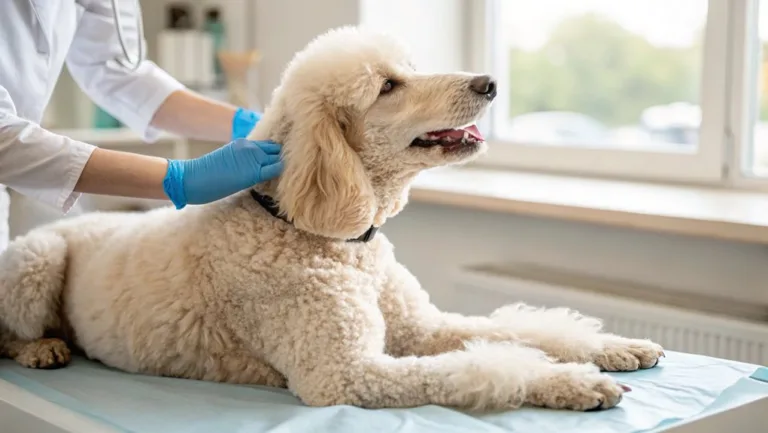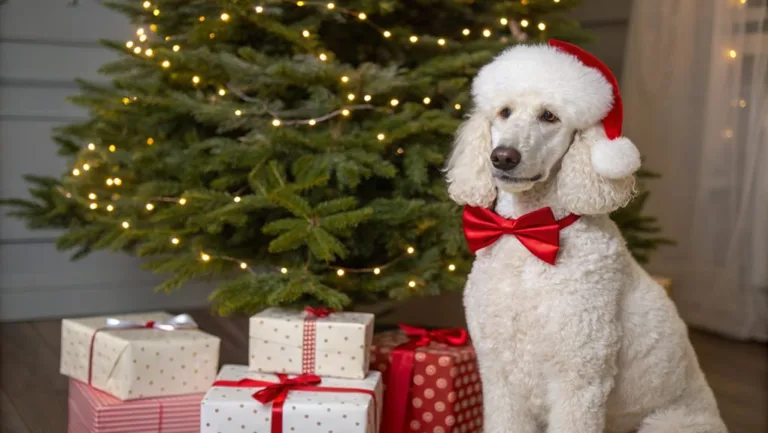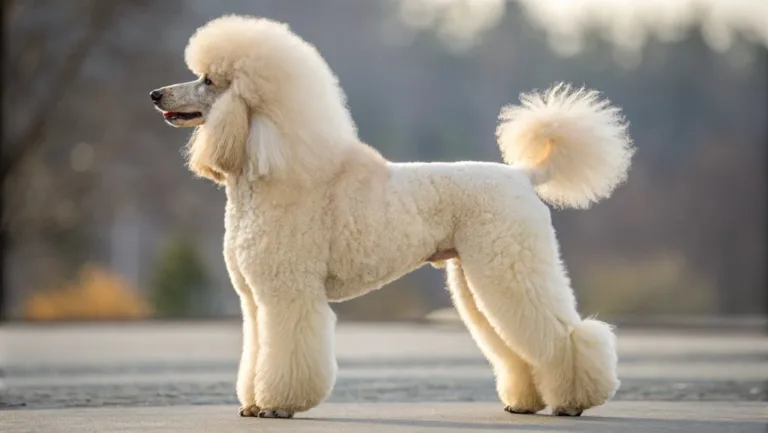How Many Times Can A Toy Poodle Get Pregnant?
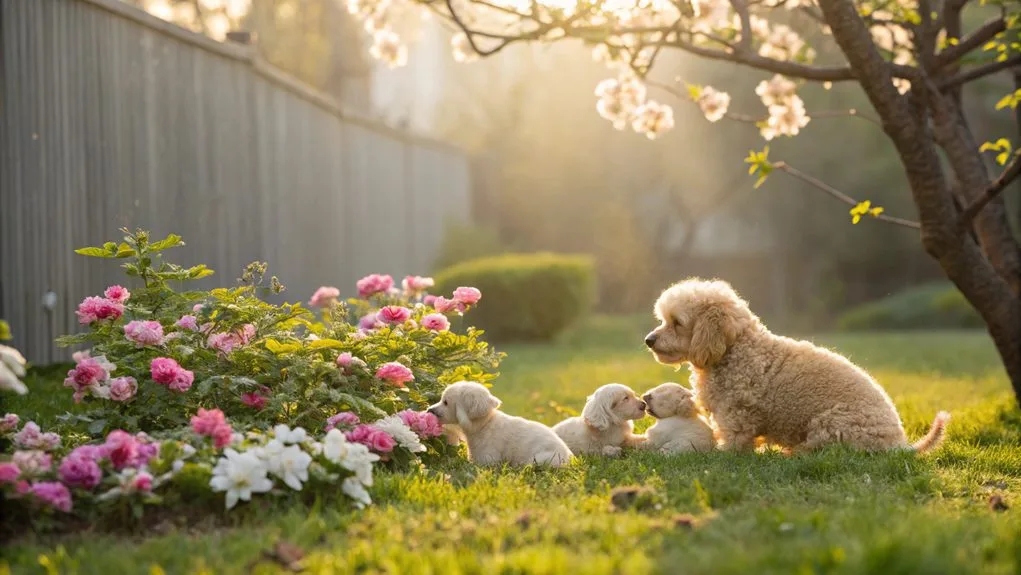
A Toy Poodle can safely get pregnant a maximum of four to six times in its lifetime. They enter heat about twice a year, typically every 6 to 7 months.
Each heat cycle lasts 3 to 4 weeks, with the best breeding window occurring 9 to 14 days after it starts. It’s vital to monitor their health throughout this process.
Frequent pregnancies can lead to health issues, so responsible breeding practices are important. If you’re curious about the signs of heat and ideal breeding practices, there’s plenty more to explore on this topic.
Understanding Toy Poodle Heat Cycles
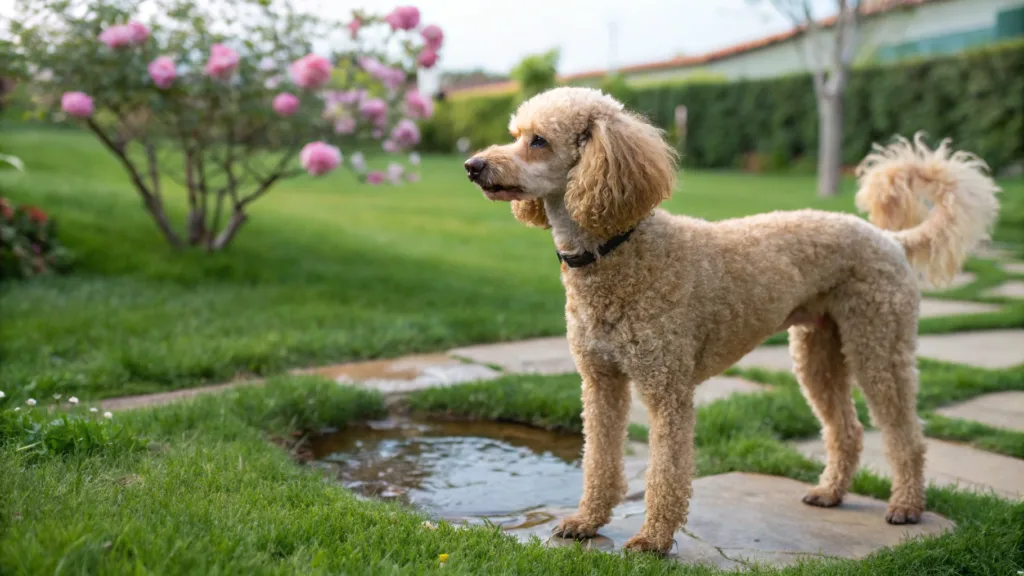
Understanding your Toy Poodle’s heat cycles is important for responsible pet ownership. As a female dog, your Toy Poodle will typically enter her first heat between 6 to 12 months of age.
During her heat cycle, which occurs about twice a year, you’ll need to be aware of the signs. Look for swelling of the vulva, increased urination, and behavioral changes such as restlessness or heightened affection. Blood-tinged discharge is also a common indicator that she’s in heat.
This cycle lasts approximately 3-4 weeks, but the fertile period is only around 1.5-2 weeks. If you’re considering breeding, timing is significant; the ideal breeding window usually falls between 9 to 14 days after the start of her heat cycle.
Regular veterinary check-ups will help you monitor her reproductive health and guarantee she’s ready for breeding if that’s your goal. Additionally, understanding the signs of pregnancy, such as changes in appetite and behavior, will be essential if you choose to breed your Toy Poodle.
Always consult with your veterinary professional for advice tailored to your dog’s specific needs.
Frequency of Pregnancy in Toy Poodles
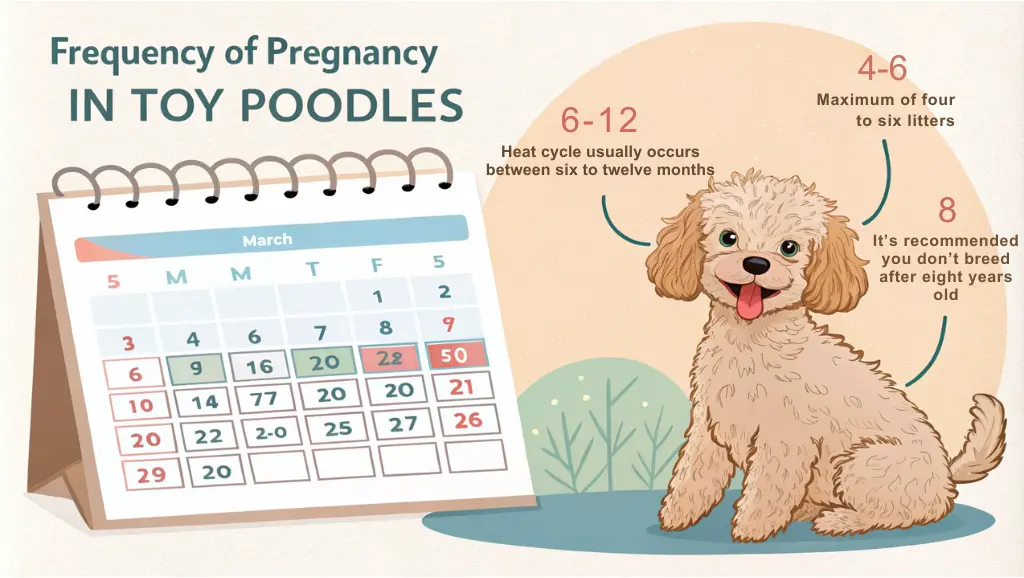
The frequency of pregnancy in Toy Poodles can vary considerably based on individual health, age, and breeding practices. Typically, these dogs go into heat every six to seven months, resulting in about two cycles per year.
The first heat cycle usually occurs between six to twelve months of age, an essential time when you should consider your options regarding spaying.
If you choose not to spay, it’s important to monitor the heat cycles carefully, as breeding during the ideal fertile period is crucial for successful pregnancies.
Most breeders recommend allowing a Toy Poodle to have a maximum of four to six litters throughout her life, spacing them out to guarantee her health and recovery.
Litter size can also influence how often you can expect a Toy Poodle to get pregnant. Smaller breeds like Toy Poodles typically have smaller litters, averaging around three puppies, sometimes even just one.
Making sure your Toy Poodle is healthy and well-cared for will help maintain a suitable frequency of pregnancy and contribute to the well-being of both the mother and her puppies.
Signs of a Poodle in Heat
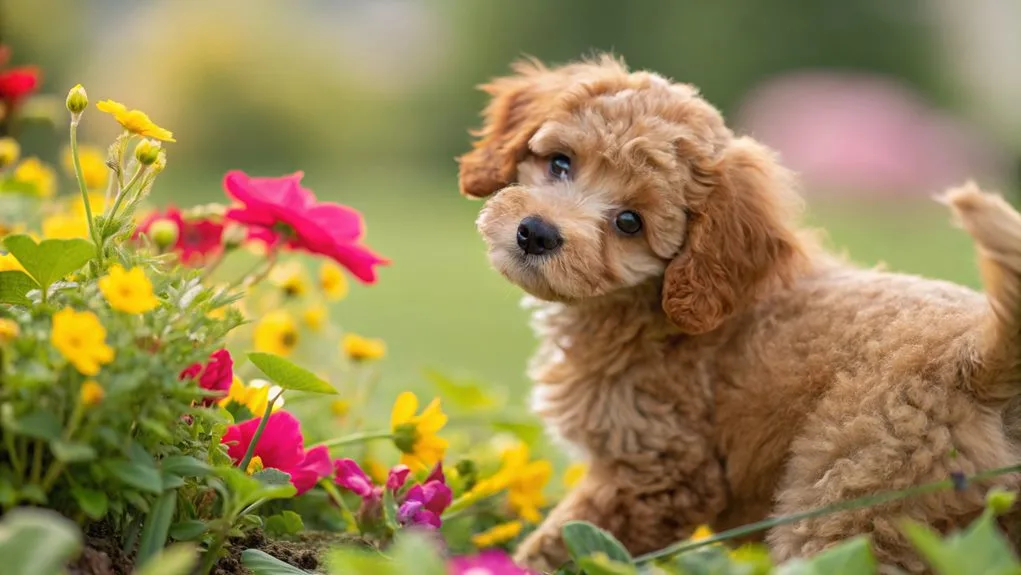
During the heat cycle, you’ll notice several signs that indicate your Poodle is in estrus. Recognizing these signs is vital for managing your dog’s health and breeding frequency. Here are three key indicators:
- Swollen Vulva: One of the most noticeable signs is swelling of your Poodle’s vulva. This change often marks the beginning of her heat cycle.
- Behavioral Changes: You may observe increased affection or restlessness. Your Poodle might seek more attention or become more irritable during this time.
- Discharge: Blood-tinged discharge can often be seen. This discharge is a common sign of a Poodle in heat and typically appears around her first heat.
It’s important to schedule regular veterinary visits during this period to monitor her health.
If you’re considering spaying, discuss the timing with your vet, especially after her first heat. Health checks before any potential breeding are also vital to guarantee she’s in good condition.
Breeding Considerations for Toy Poodles
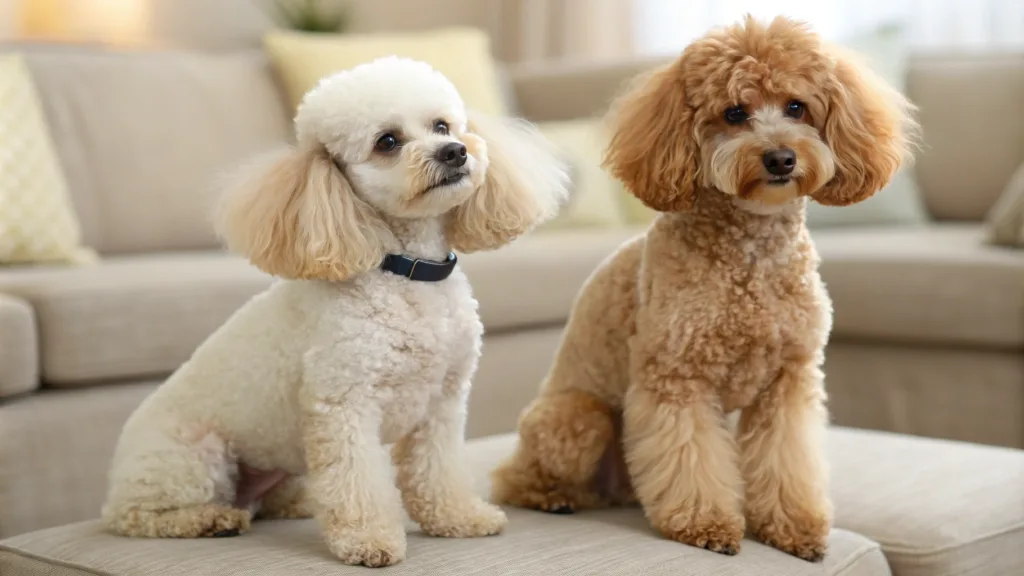
Recognizing when your Toy Poodle is in heat opens the door to significant breeding considerations. During her first heat, which usually occurs between 6 to 12 months, it’s important to assess her overall health and readiness for breeding.
Before proceeding, make certain to schedule health checks with your vet to guarantee she’s in prime condition.
The best breeding time typically falls between 9 to 14 days after the heat cycle begins. This is when she’s most fertile, increasing the chances of a successful mating.
Don’t forget to conduct genetic health screenings for both the male and female to mitigate potential inherited health issues.
Practicing responsible breeding practices is essential for the well-being of both your Toy Poodle and her puppies. Overbreeding can lead to health complications, so it’s important to space out litters and allow your Poodle sufficient recovery time between pregnancies.
Always prioritize her health and welfare throughout this process. By being proactive and informed, you can guarantee a healthier breeding experience and contribute positively to the breed’s future.
Health Implications of Frequent Breeding

Frequent breeding can lead to serious health complications for your Toy Poodle. Overbreeding can put immense strain on your dog’s body, especially if she’s bred after the age of 8.
It’s crucial to take into account the following health implications:
- Increased Health Conditions: Regular pregnancies can increase the risk of various health conditions, including infections and hormonal imbalances. Each pregnancy takes a toll, making recovery more challenging after each litter.
- Limited Recovery Time: Insufficient spacing between litters can prevent your Poodle from fully recovering. Ideally, you should allow her a break to regain her strength before evaluating another breeding cycle.
- Need for Health Checks: Before breeding, it’s vital to conduct thorough health checks and genetic health screenings. This guarantees your dog is fit for pregnancy and can help identify any potential hereditary issues.
Responsible show breeding emphasizes the importance of monitoring breeding frequency and prioritizing your Poodle’s health.
Optimal Breeding Times for Toy Poodles
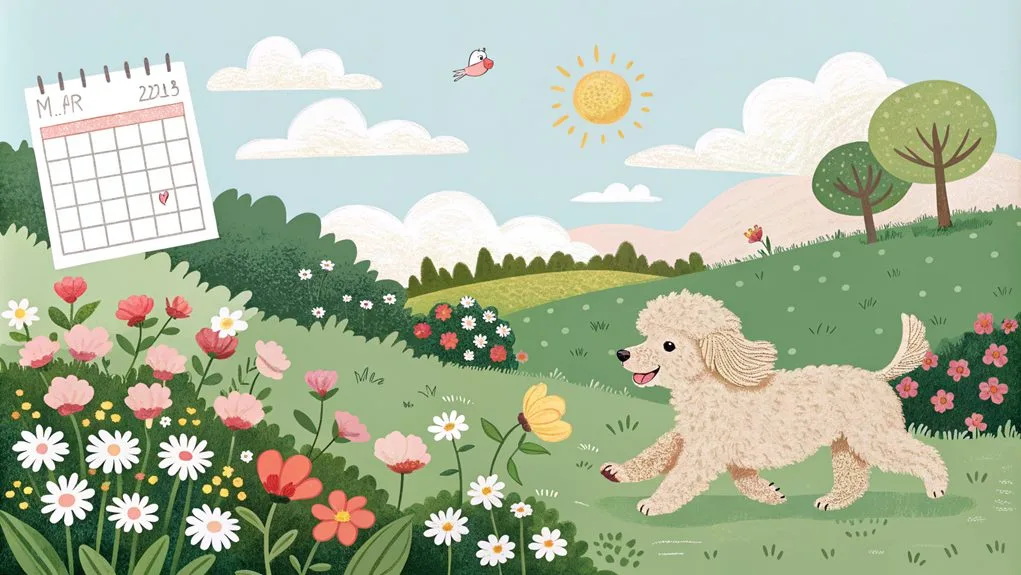
Understanding the ideal breeding times for your Toy Poodle is key to guaranteeing a healthy pregnancy and successful litter.
Toy Poodles typically enter their heat cycle every 6 to 7 months, averaging about twice a year. The best time for breeding is usually between 9 to 14 days after the heat cycle starts, as this is when your Poodle is most fertile.
Monitoring her signs, such as vulvar swelling and behavioral changes, can help you pinpoint the most favorable breeding times.
Responsible breeding practices start with regular veterinary checkups. Confirm that both the male and female have undergone health screenings to assess genetic health.
These checkups can help prevent potential complications during pregnancy and guarantee the overall well-being of both parents.
Responsible Breeding Practices and Ethics
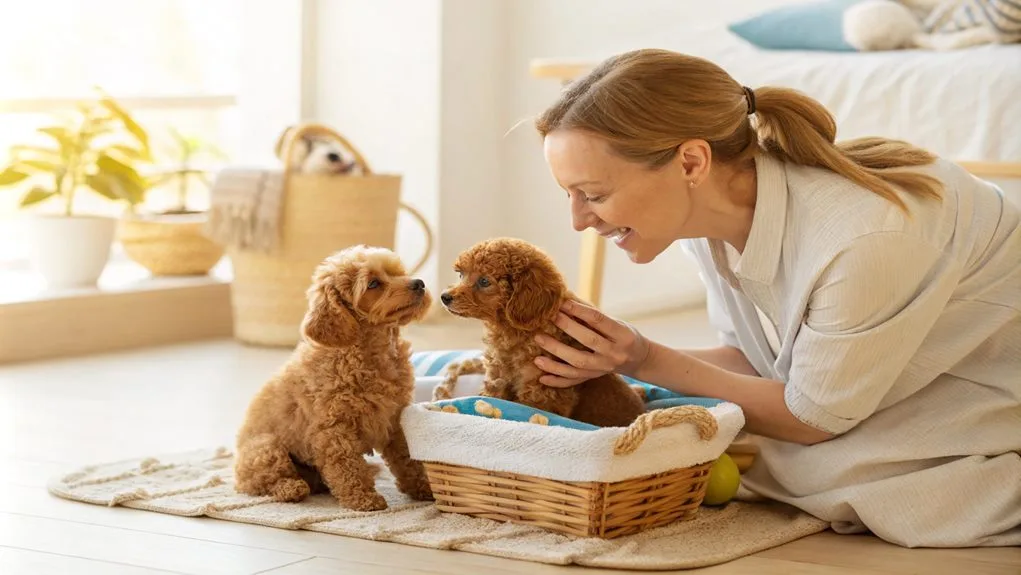
Responsible breeding practices are essential for guaranteeing the health and welfare of both Poodles and their puppies.
You need to prioritize their well-being through ethical breeding. Here are three key principles to follow:
- Conduct Regular Health Checks: Before breeding, guarantee both parents undergo thorough health checks. This includes screenings for genetic health issues common in Poodles.
- Limit Breeding Frequency: To promote the well-being of your Poodle, avoid breeding her every heat cycle. Ideally, limit her to four to six litters in her lifetime, giving her ample time to recover in between.
- Consider Spaying: If you’re not planning to breed your Poodle, consider spaying her. This not only prevents unwanted litters but also reduces the risk of certain health problems.
Conclusion
In summary, understanding your Toy Poodle’s reproductive health is essential for responsible breeding. Remember, they typically cycle every six to seven months, allowing for two potential pregnancies each year. However, prioritize their health and well-being throughout the process.
Always look for signs of heat, and consider the best breeding times while being mindful of the health implications of frequent breeding. By following these guidelines, you can guarantee a healthy experience for both your Poodle and her future puppies.
FAQ: How Many Times Can A Toy Poodle Get Pregnant?
A female poodle can become pregnant multiple times throughout her life, but the exact number depends on factors such as her health, age, and the decision of the poodle owners. Typically, a toy poodle should not breed every heat cycle, which occurs approximately twice a year. Responsible poodle owners and veterinarians often recommend allowing a female poodle to have no more than three to four litters in her lifetime to ensure her health and well-being.
A toy poodle can become pregnant as early as 5-6 months old, but it is not advisable to breed a toy poodle at this age. Most veterinarians and breeders recommend waiting until the poodle is at least 2 years old to ensure she is fully mature and healthy. Breeding too early can pose health risks to both the mother and the pups.
The gestation period for a toy poodle is similar to that of other dogs, lasting approximately 63 days. During this time, it is crucial to provide appropriate care and nutrition to ensure a healthy poodle litter. Regular check-ups with a veterinarian can help monitor the poodle’s pregnancy and address any concerns.
The size of the litter for a toy poodle can vary, but typically, they have smaller litters compared to larger breeds. A typical poodle litter may consist of 1-4 pups. Factors such as the female poodle’s health, age, and genetics can influence the number of puppies born.



